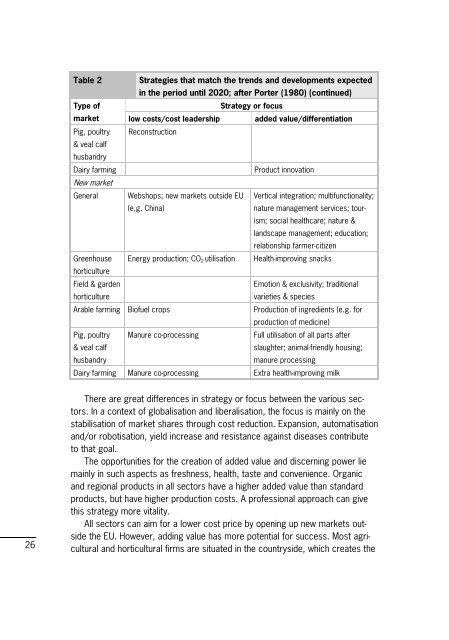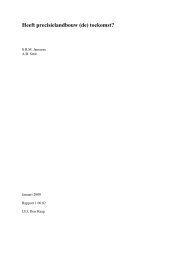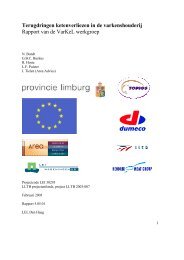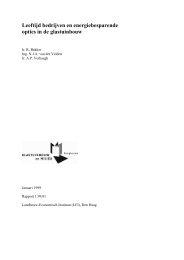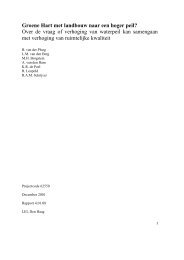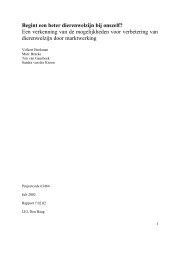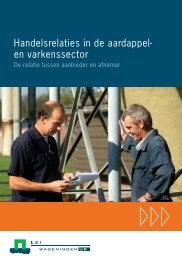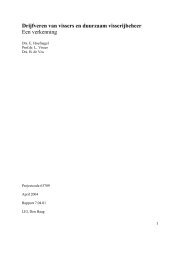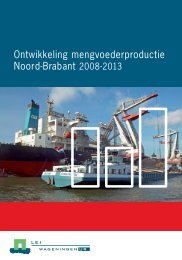- Page 1 and 2: Samen werken aan samenwerking
- Page 3 and 4: 2 LEI Wageningen UR kent de werkvel
- Page 5 and 6: 4 Inhoud Woord vooraf 7 Samenvattin
- Page 7 and 8: 6 Bijlagen 1 Theoretische achtergro
- Page 9 and 10: 8 (Van Staalduinen Communicatie) he
- Page 11 and 12: 10 - Welke samenwerkings- en ondern
- Page 13 and 14: 12 De impact op deelsectoren De ond
- Page 15 and 16: 14 te bieden. Exclusieve productken
- Page 17 and 18: 16 meer nadelen dan voordelen aan v
- Page 19 and 20: 18 korte termijn noodzakelijk wordt
- Page 21 and 22: 20 Een praktisch handvat In relatie
- Page 23 and 24: 22 Summary Cooperation in partnersh
- Page 25: 24 Table 1 Developments and trends
- Page 29 and 30: 28 tural entrepreneurs also coopera
- Page 31 and 32: 30 bandry). In the catering and rec
- Page 33 and 34: 32 - Entrepreneurs In general, entr
- Page 35 and 36: 34 1 Inleiding 1.1 Aanleiding De we
- Page 37 and 38: 36 zijn voor de agrarische sector e
- Page 39 and 40: 38 waarden waaronder samenwerking k
- Page 41 and 42: 40 Als gevolg van de veranderingen
- Page 43 and 44: 42 1.6 Effecten Dit rapport is erop
- Page 45 and 46: 44 2 Materiaal en methoden Dit rapp
- Page 47 and 48: 46 evalueren of om strategie te bep
- Page 49 and 50: 48 dag van het AgroCenter voor Duur
- Page 51 and 52: 50 Tabel 3.1 Samenvatting van de tr
- Page 53 and 54: 52 ken van dierziekte hebben de dis
- Page 55 and 56: 54 van een level playing field in E
- Page 57 and 58: 56 vindt ook op dit vlak innovatie
- Page 59 and 60: 58 den toegevoegd, omdat ze volgens
- Page 61 and 62: 60 Daarin liggen grote opgaven en u
- Page 63 and 64: 62 bouw wordt in dit onderzoek aang
- Page 65 and 66: 64 4.2 Trends en ontwikkelingen in
- Page 67 and 68: 66 in het aantal bedrijven te verwa
- Page 69 and 70: 68 alleen vanwege de lagere kostpri
- Page 71 and 72: 70 ceptatie bij alle toepassingen i
- Page 73 and 74: 72 bode van wat de varkenshouderij
- Page 75 and 76: 74 Hoewel beperkt van omvang levere
- Page 77 and 78:
76 door een loonwerker of door een
- Page 79 and 80:
78 omassa en mest) wordt elektricit
- Page 81 and 82:
80 De mogelijkheden voor het creër
- Page 83 and 84:
82 Ketenbeheer wint snel terrein, a
- Page 85 and 86:
84 huishoudens zal toenemen. Dit he
- Page 87 and 88:
86 tot nu toe leverde. In de tweede
- Page 89 and 90:
88 4.5.5 Zorg ondernemers met vakma
- Page 91 and 92:
90 Strategische opties - Lage koste
- Page 93 and 94:
92 De overige agrarische sectoren z
- Page 95 and 96:
94 Aandacht voor milieu- en diervri
- Page 97 and 98:
96 samenwerking is om de afzet van
- Page 99 and 100:
98 tussen de producent en de afneme
- Page 101 and 102:
100 verschijnsel zijn. Dit komt omd
- Page 103 and 104:
102 binnen- en buitenlandse commerc
- Page 105 and 106:
104 Van vrijblijvendheid naar unifo
- Page 107 and 108:
106 Figuur 5.1 Redenen om samen te
- Page 109 and 110:
108 Samenwerking in de industrie he
- Page 111 and 112:
110 5.4 Slotopmerkingen Samenwerkin
- Page 113 and 114:
112 6 Praktijkvisie op samenwerking
- Page 115 and 116:
114 bij ondernemers de neiging om m
- Page 117 and 118:
116 Verbetering van de bedrijfsposi
- Page 119 and 120:
118 Benutting van complementaire co
- Page 121 and 122:
120 kan uitgroeien tot een strategi
- Page 123 and 124:
122 - technologieontwikkeling; - pe
- Page 125 and 126:
124 Voorbeeld van samenwerking tuss
- Page 127 and 128:
126 duele producenten. Samen hebben
- Page 129 and 130:
128 Tabel 6.1 Voor- en nadelen van
- Page 131 and 132:
130 de nadruk op regionale producti
- Page 133 and 134:
132 Transportsector De transportsec
- Page 135 and 136:
134 joint ventures en tijdelijke or
- Page 137 and 138:
136 culturele overeenkomst vormen e
- Page 139 and 140:
138 2000). Eerdere studies conclude
- Page 141 and 142:
140 6.6 Uitkomsten workshops 1 6.6.
- Page 143 and 144:
142 cipe 'Survival of the Fittest'.
- Page 145 and 146:
144 nemers. Ten slotte leidt latera
- Page 147 and 148:
146 als belemmering. Blijkbaar kan
- Page 149 and 150:
148 7 Naar de toekomst toe In dit h
- Page 151 and 152:
150 Toename welvaart Bij deze trend
- Page 153 and 154:
152 Schaalvergroting Deze trend zal
- Page 155 and 156:
154 te onderscheiden. In dit geval
- Page 157 and 158:
156 Tabel 7.3 Voor- en nadelen van
- Page 159 and 160:
158 Tabel 7.4 Noodzakelijke aanpass
- Page 161 and 162:
160 7.2 Toekomstbeelden in de works
- Page 163 and 164:
162 genwoordigers van de doelgroepe
- Page 165 and 166:
164 - een prikkelende checklist om
- Page 167 and 168:
166 Literatuur Agrarisch Dagblad, 1
- Page 169 and 170:
168 Diepen, M. van, Een inventarisa
- Page 171 and 172:
170 Jong, R. de, L. Noorduyn, L. Sc
- Page 173 and 174:
172 Oerlemans, L.A.G. en M.T.H. Mee
- Page 175 and 176:
174 Gewasbeschermingsverordening. E
- Page 177 and 178:
176 Bijlage 1 Theoretische achtergr
- Page 179 and 180:
178 via een dergelijke indeling bes
- Page 181 and 182:
180 1990). Buiten kijf staat dat ee
- Page 183 and 184:
182 Duurzaamheid Deze dimensie gaat
- Page 185 and 186:
184 11:30 AM 4a. Opzetten van samen
- Page 187 and 188:
186 Macro- omgeving Concrete trends
- Page 189 and 190:
188 Macro- omgeving Concrete trends
- Page 191 and 192:
190 - Veranderende smaak- en prefer
- Page 193 and 194:
192 - Toenemende aandacht voor mili
- Page 195 and 196:
194 Bijlage 5 Uitkomsten GDR-worksh
- Page 197 and 198:
196 - Gebondenheid aan de historie
- Page 199 and 200:
198 - Processen: - Procesondersteun
- Page 201 and 202:
200 - Wegvallen van het oorspronkel
- Page 203 and 204:
202 - dat sommige ondernemers socia
- Page 205 and 206:
204 - Het faciliteren van 'kartrekk
- Page 207 and 208:
206 RECHTSPERSONEN Besloten vennoot
- Page 209 and 210:
208 ALLIANTIES Formele alliantie Bi
- Page 211 and 212:
210 maar krijgt steeds meer het kar
- Page 213 and 214:
212 Tijdelijke organisaties worden
- Page 215 and 216:
214 subsidie is bedoeld voor projec
- Page 217 and 218:
216 Farmers4all bv Farmers4all is e
- Page 219 and 220:
218 voor de regeling aangemeld. Uit
- Page 221 and 222:
220 - Plattelandstoerisme. - Educat
- Page 223 and 224:
222 Superunie Superunie is een inko
- Page 225 and 226:
224 Groep Gerechtsdeurwaarders Nede
- Page 227 and 228:
226 Bakker Bart De franchiseketen B
- Page 229 and 230:
228 Visgilde Visgilde is een coöpe
- Page 231 and 232:
230 Happy Huisdier Onder de naam Ha
- Page 233 and 234:
232 Bijlage 7 Adviesorganisaties in
- Page 235:
LEI Wageningen UR ontwikkelt voor o


